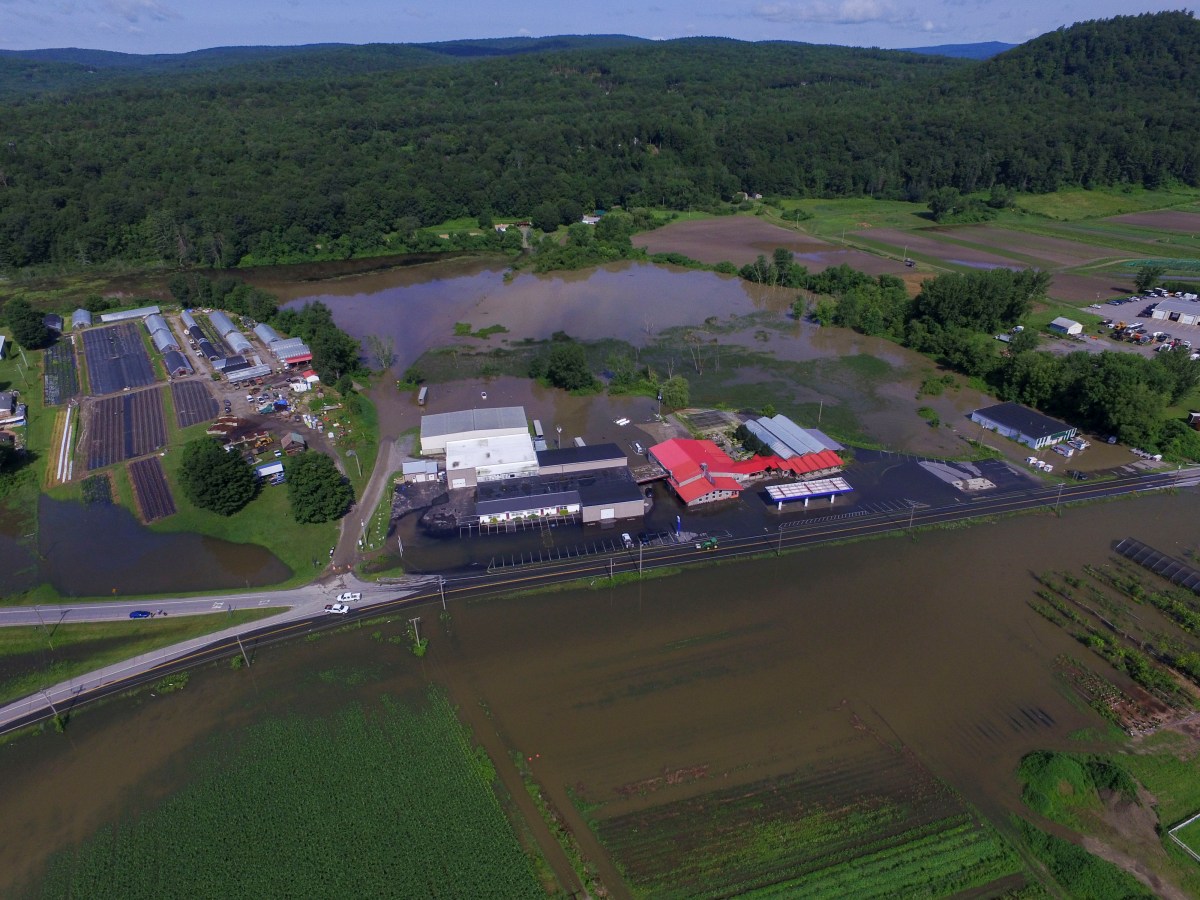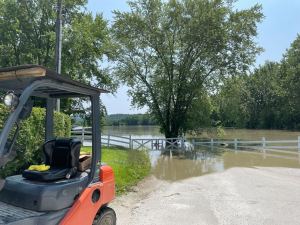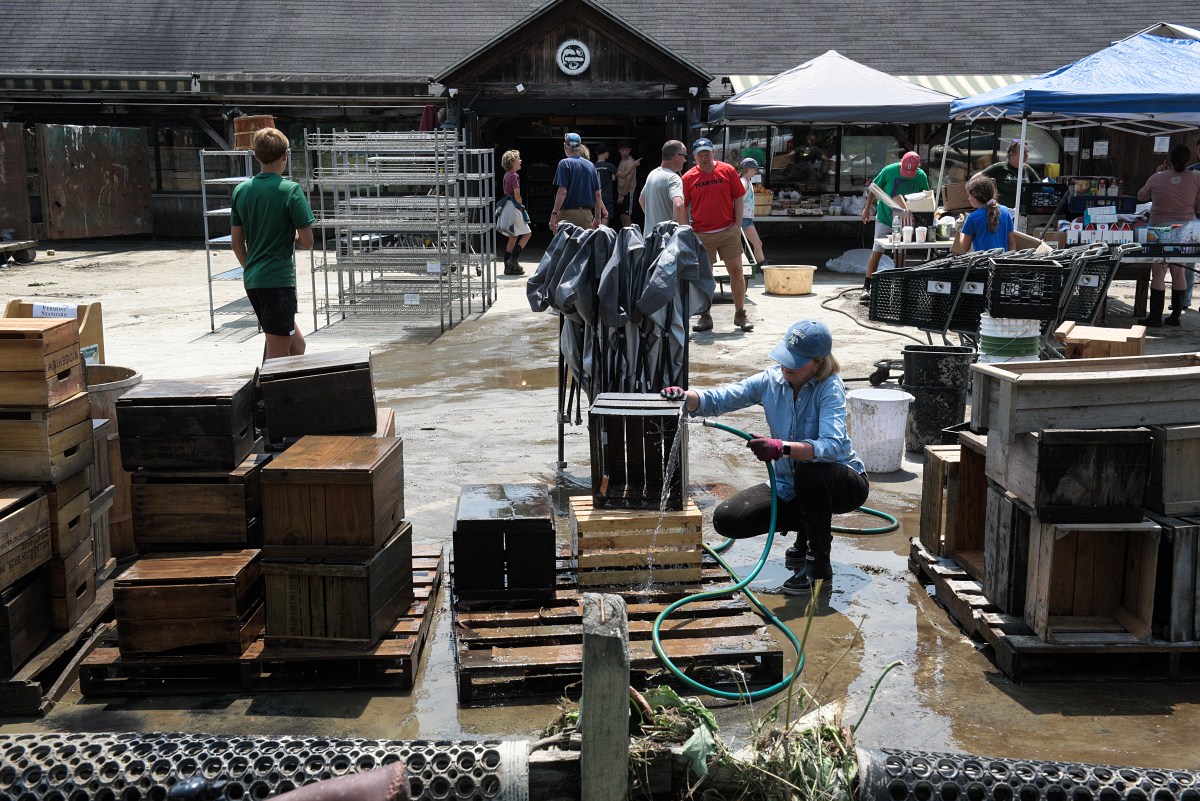
Normand Thibault’s 200-cow dairy farm in Colchester sits on the last plateau before Lake Champlain.
“I’m on the lake level,” he said. “No dams after me.”
The result after heavy rain on Sunday and Monday: nearly 110 acres of corn and 160 acres of hay submerged under 4 feet of water. As his is the last farm before water feeds into the lake, Thibault had been playing the waiting game since his fields began filling up late on Monday.
Fifty acres of hay were ready for chopping, Thibault said, but that has “gone under and is probably destroyed now.” His corn is still in the wait-and-see stage. It is still covered, but he wasn’t too optimistic, since the feed crop can go only two or three days underwater before spoiling from lack of oxygen.

“It’s going to be a very stressful time for farmers and all throughout the state right now,” he said. “Is there enough feed available throughout the state to cover all the losses that will happen? Probably not.”
Along with tarnished cow feed, dairy farmers across the state also face difficulties shipping out milk to processing plants. Anson Tebbetts, the state’s secretary of agriculture, food and markets, cited Route 2 around Montpelier as a primary problem, but he also noted various processing plants have had to limit output or shut down entirely because they were not getting deliveries on time.
Thibault, already facing extreme crop damage, took a different route.
“They did close my road off, but the water had gone off the road so I pulled the signs out of the way for the milkman to go through,” he said. “The milk’s gotta move.”
This is the story of Vermont’s agriculture industry in the wake of catastrophic flooding.
“The season is over for some people,” said Grace Oedel, executive director of the Northeast Organic Farming Association of Vermont. “And the season is drastically affected for many, many others.”

As most farmers are just beginning to get out to their fields and assess the damage, and with some, like Thibault, still waiting for their properties to drain, the long-term effects of this week’s storm are still uncertain.
Most of the heavy damage took place along the Winooski, Lamoille and Missisquoi rivers, Oedel said, and she described the current situation as a “harm mitigation phase.”
Where flooding was heavy, vegetable fields turned into murky lakes topped with debris. Fast-flowing rivers ripped out soil across the state and took crops along with it, leaving some freshly planted fields unrecognizable just days later.
“It will be some weeks really before we know the full extent of the impact,” Oedel said. “But people are starting to assess how bad it is, and we think that it will have a real Irene-like impact, if not more intense, for a lot of farms.”
She’s been talking regularly to people from both University of Vermont Extension and the Vermont Agency of Agriculture, Food and Markets about how to best meet farmers’ needs.
Listening to people, checking in with lawmakers, and trying to find patterns in damages are all part of the effort to ensure federal, state and local organizations can efficiently deploy resources to farmers, she said.
The state agriculture department put out a list on Wednesday that aims to centralize all the information available to farmers right now, including how to report losses and specific guidance for dairy, meat and produce operations.
NOFA, Intervale Center, the Center for an Agricultural Economy and the Vermont Community Foundation have more immediate funding available while the specifics of federal relief get sorted out. NOFA also has a survey available for farmers to report any flood damage, crop losses and desired recovery resources.

Oedel said that, if people are able, they “should show up for their local farmer in any way they can think of,” whether volunteering, making donations or something else. The most important thing, she said, is to be there for each other.
“We all need each other,” Oedel said. “And finding a way to let those people who keep us fed know that we’re here for them when we need to be is what we all can do right now.”
Long-term relief
Though federal emergency aid has already been approved by President Biden, delivering that aid is another matter.
Tebbetts, the state agriculture secretary, said his agency is actively working with the U.S. Department of Agriculture, Gov. Phil Scott and the Vermont congressional delegation to make sure federal relief money will be available for agriculture.
Deanne Criswell, administrator of the Federal Emergency Management Agency, traveled the state Wednesday to join Gov. Scott and the delegation to get a better grasp on the realities on the ground that Vermonters face. That was the first part of the data- and information-gathering process that will help shape the scope and targets of federal relief, Tebbetts said in an interview Wednesday.
The arrival of federal help “won’t be immediate,” he said, but “everyone is focused on getting aid to Vermont into the ground as soon as possible.”

Thibault said he has heard that agencies are working on a plan, but given the uncertain timeline, his and most other farmers’ efforts are focused on tending to their own properties and animals as the water finally begins to subside.
“When’s it going to be available, though? It might be six months down the road,” he said. “We don’t know. There’s a lot of unknowns right now.”
‘The climate catastrophe is really increasing’
Between hot weather in early spring, a frost in May and poor air quality stemming from northern wildfires, the growing season has already been a tumultuous one for Vermont farmers. Throw historic flooding into the mix, and it makes sense why Oedel acknowledged growing concerns about “climate catastrophe” in Vermont’s agricultural community.
“Last week we were out dealing with people breathing in smoke from Canadian wildfires as they were working in their fields,” she said. “And this week, we’re dealing with catastrophic, 100-year floods that have completely ended the season. We need to act like there’s a climate crisis and like we are going to deal with it effectively.”
Ironically, farmers do work to help mitigate the effects of climate change. They sequester carbon in healthy soils, foster biodiverse ecosystems and help feed vulnerable community members.
But the difficulty in making farms more extreme-weather-resistant is that there will always be something they just cannot prepare for, Oedel said. Even in the days leading up to this week’s flood, it wasn’t anticipated to be as bad as it turned out.

“Like nobody was talking about catastrophic flooding. We didn’t really know that was coming before it came,” she said. “I think what it shows me is that it’s really hard to predict all of the climate weirdness that’s going to happen.”
On the one hand, farmers will want to have systems in place to prevent worst-case effects, but resilience will remain a big part of the culture because the unexpected is sure to strike again, she said.
This is the second 100- to 500-year flooding event in the last 12 years. Tropical Storm Irene was the first. Oedel said that, because of lessons learned from Irene, the agriculture industry was more prepared and organized when waters began to rise on Sunday night.
“While the damage is really intense, we have done this before, so we have some practice about how to handle it,” she said.
The Thibault farm also experienced flooding during Irene, but because it was later in the season — it hit in late August — they didn’t lose any hay, and corn was tall enough to be unaffected. This time around it’s a much different story.
“We lucked out on it then,” Normand Thibault said. “But I don’t think we’re gonna luck out on this one.”
